In the ‘70s, ’80s, and ’90s, mountain bikes were effectively designed for, and marketed to, men. At the same time, a few bold females were pioneering the sport for women. Inspired by this movement, Juliana Bikes felt it was time for a change. In 1999 they created the first mountain bike aimed specifically at female riders, and it was a groundbreaking shift in focus for the industry, so what makes Julianna Bikes so great?
Juliana Bikes pioneered advanced materials and production methods to build the most durable and high-performance bicycles because it’s the way to ensure that riders can just enjoy riding their bike. The company’s experience with carbon fiber production allows them to build bikes that are reliable and durable.
Are you currently interested in possibly trying out a Juliana bike? Perhaps you are curious about the company but are also wondering if a Juliana model is really the right fit for you? Whatever your interests or concerns may be, this article is for you. In this comprehensive guide, we are going to take a deep dive into Juliana Bikes by taking a look at the company, it’s bike manufacturing process, and reviewing a range of their most popular bike models.
Juliana Bicycles
Juliana specializes in producing high-end mountain bikes that are typically designed and refined for women. The company’s major mission is to encourage more women to join in cycling and enjoy the best of mountain biking.
Nowadays, bicycles built especially for women are not uncommon. In fact, a lot of bike brands adjust their men’s bikes to make them better suit female riders.
Nevertheless, Juliana Bicycles is much more than that. Instead of just “miniaturizing and coloring” its bicycles, Juliana creates bikes with specific geometry optimized for women’s anatomy. What’s more, the company tunes the suspension to ensure that it works well under more lightweight loads since female riders usually weigh 30 pounds less than male riders on average.
Juliana builds superior, race-ready, high-end carbon mountain bikes. Typically, these bikes have been tested over and over again in different top-level races by some of the most successful female riders all over the world. Back in 1999, Juliana “Juli” Furtado, one of the best mountain riders in history, established Juliana Bicycles.
As lots of you might know, the 1980s and 1990s were considered the “golden years of mountain biking”. However, most bikes were often manufactured and sold to men. It was Juliana’s opening move that changed the situation by developing the very first mountain bike typically geared towards female riders in partnership with Santa Cruz.
Then, in 2013, Juliana completely merged with Santa Cruz as a sister company. However, both brands are currently located in Santa Cruz, California. And of course, they share manufacturing and Research and Development facilities overseas.
Even though almost all Juliana bikes reflect Santa Cruz’s products, Juliana’s models still feature several unique things. For example, they vary in size, saddles, suspension tuning, grips, and colors.
In addition, Juliana female bicycles also borrow innovative technologies from Santa Cruz. Therefore, you will find Juliana Bicycles boasting themselves with high-end carbon materials, light carbon rims, cutting-edge Virtual Pivot Point suspension. Not only producing premium bikes for women, but Juliana also does a crucial job when it comes to authorizing the female mountain biking community by sponsoring athletes, ambassadors, adventures, and elite racing teams.
Some of the most prominent names here are Anka Martin, Rachael Walker, Brooklyn Bell, Aneela McKenna, etc.
Lots of you might know that Santa Cruz is the parent company of Juliana. Both bike brands are currently based in Santa Cruz, California. As mentioned, they also use the same Research and Development and manufacturing facilities in foreign countries. Accordingly, the frame construction is done in Taiwan and China. However, all of their bikes are assembled in Santa Cruz and built based on customers’ specifications before being delivered.
When it comes to technology, Juliana is proud of cutting-edge technologies from Santa Cruz. In particular, the brand has adopted one of the most innovative technologies from its sister company, the Virtual Pivot Point suspension system for their bicycles.
The brand has used the Virtual Pivot Point since 2001, because this suspension system is typically designed to be supported by manufacturers for a long time. Therefore, when you need to maintain your bike, there is nothing that makes you feel the system is outdated. What’s more, the Virtual Pivot Point system can be optimized for specific riders to ensure the best riding experience.
For example, if you love to ride a shorter travel bicycle, such as a cross-country bike, you can also take advantage of the Virtual Pivot Point to ensure every watt gets delivered to the bicycle, instead of wasting energy on impacts. Having said that, Juliana Bicycles offers completely different models when compared to some other competitors.
The company creates bikes with geometry that is improved to better suit female riders’ anatomy instead of just “miniaturizing and coloring” its bikes. And this is one of the reasons making Juliana bicycles perform well on most trails.
In addition, the company adjusted the suspension system to make sure it performs well under more lightweight loads since male riders usually weigh 30 pounds more than female ones.
Another great thing about Juliana bikes is their proven performance. The brand produces high-performance, race-ready, and superior carbon mountain bicycles.
Typically, these bikes have been all tested over and over again by different famous female riders over the world in various top-level races.
Juliana Bike Specifics
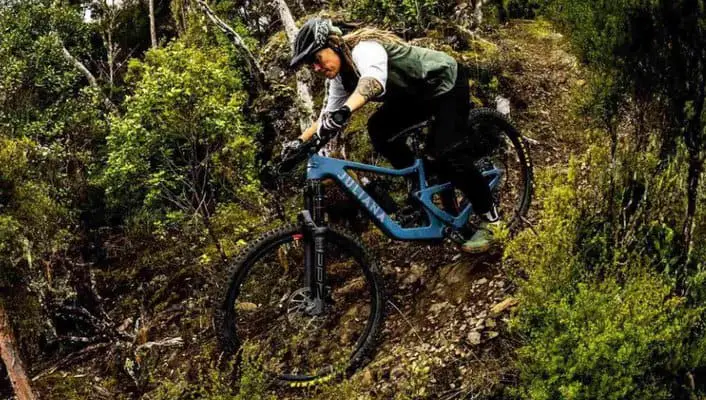
Juliana Bicycles is one of the first pioneer bike brands, producing the very first mountain bike for female riders in the late 1990s. Since then, the brand has branched out its bike category to gravel range and other suspension mountain bicycles. It could be said that Juliana Bicycles is a quite expensive bike brand that manufactures high-end bikes that might be considered a long-lasting investment.
In fact, Juliana produces some of the best women-specific off-road bikes in the industry. So, it could be said that Juliana’s bikes are very of great quality. The brand also offers different high-end carbon trail models that are specially made for serious amateur riding and pro competitions.
All of their bikes are manufactured with women riders in mind and also tested and enhanced by some of the best female racers in the world. Just similar to its big sister Santa Cruz, Juliana Bicycles only concentrates on manufacturing high-end bicycles for off-road riding. As a result, its lineup is relatively small, which includes only enduro, cross country, and trail full-suspension mountain bikes, as well as only one cyclocross and gravel model with 700c/650b wheels.
Juliana Bicycles currently provides the market with only six models in total, Furtado (27.5-inch), Joplin (29-inch), Maverick (29-inch), Quincy (700c/650b), Roubion (Mullet), and Wilder (29-inch).
Almost all of these bikes are made of lightweight carbon frames (except for some models coming with aluminum frames). They are also equipped with mid-range or premium components from famous brands, such as SRAM and Shimano. And the main purpose is to offer the best performance.
VPP is typically optimized to deliver the proper balance between trail-crushing power and pedaling capability. What’s more, this suspension system can significantly remove power loss while you are riding. More importantly, it works with most ordinary shocks.
Another wonderful thing about Juliana bicycles is that the brand offers a lifetime warranty with their bikes and bearings. Accordingly, you can get free bearing replacements whenever you want.
The only thing to consider is that Juliana bikes are not really budget-friendly.
Is Juliana Owned By Santa Cruz?
Yes, Juliana is a dedicated women’s mountain bike manufacturer that is proud to produce high quality bikes catering to beginners and aggressive female riders alike. All of Juliana’s bikes are designed, built and tested in California with the help of sister company Santa Cruz Bicycles.
The concept of a committed women’s bike brand came about in 1999 when accomplished mountain biker Juli Furtado worked with Santa Cruz to design the first ever women’s-specific mountain bike. During her career Juli won five National Championships, three World Cup titles and two World Championships. She noticed that women were significantly underrepresented in the mountain bike market.
After her retirement in 1997, she made it her goal to offer women the best performing, most comfortable, and most beautiful mountain bikes possible. Since then, Juliana Bicycles has evolved into a successful staple of the mountain bike community.
Juliana currently offers six awesome mountain bike models, ranging from a hardtail XC bike to a full suspension, all-mountain “Enduro” bike. With Santa Cruz’s patented VPP and carbon fiber technology, Juliana is able to manufacture some of the highest quality women’s bikes on the market.
Juliana’s professional mountain bike team includes talented riders Anka Martin, Sarah Lieshman and Kelli Emmet, and the company is committed to telling the story of the women who love to mountain bike.
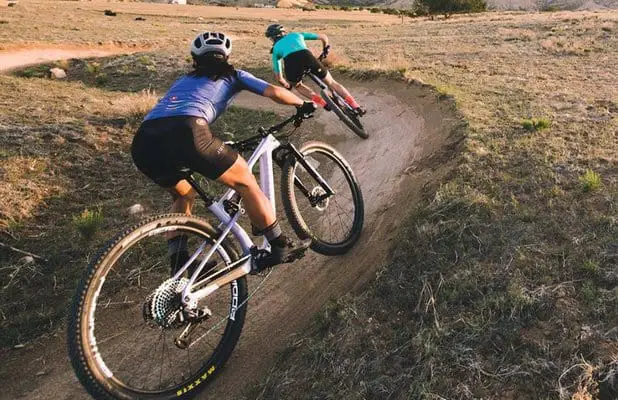
Where Are Juliana Bikes Made?
It doesn’t matter how well designed your frame is or how many fancy knobs and levers you can click on your shock—if the internal parts of your suspension aren’t properly tuned for you, you’ll never get the most from your ride. At Juliana, the company likes to get a bit rowdy on technical trails because it’s all part of the fun, which is why design is so important.
But it should happen in a manner that’s balanced and controlled, which only happens when the suspension is right for you. However, mountain bike suspension is historically tuned with male riders in mind, simply because they represent a larger portion of the market. In the United States, the mean-average male weight is a solid 30 pounds more than that of the average American woman.
If a stock shock is tuned to work best for the average guy, it will not perform optimally for the average woman. So, what did Juliana do about it? Juliana staff work closely with Santa Cruz engineers, and the technicians at Fox and RockShox, to develop custom tunes that bring out the best in each of their models.
They then test those products amongst a diverse group of women to ensure theory meets reality. They’re looking for a tune that delivers the best balance of traction and control in the widest variety of situations, and the result is what makes Juliana different.
The Joplin, for example, features all the same great engineering and geometry traits as the Santa Cruz Tallboy, however it offers the typically lighter Juliana rider a plush and smooth feel throughout the travel, thanks to its custom ‘light’ tune.
Juliana’s component selection refines your ride even further because they know people like to customize their bikes to suit their individual needs, but their aim is to deliver a product you can ride straight out of the shop with no messing around. From shock tune to chainring size and saddles to grips, Juliana’s crew of dedicated female product testers have poured over all the subtle details a modern female mountain biker wants.
They don’t shout about these details all over the bike itself because they don’t feel they need to.
How Are Juliana Bikes Different?
There have been bicycles designed specifically for women for more than a century now. The basic step-through bicycle—what’s often called a “girl’s bike”—was born in the 1880s and immediately made riding, and catching air in a hoop skirt, a whole lot easier.
Fast forward a century or so and a new “women’s specific” bike geometry arose. It was based on the theory that women have (proportionally) shorter torsos and longer legs than men. And it led many bike companies down the path of creating women’s mountain bikes with a shorter reach and a taller front end.
This approach, which creates a more upright riding position, was also said to help inexperienced or timid riders feel more comfortable. Sure, it might feel good when you first sit on it and take a quick pedal around the bike shop, but when it comes to mountain biking and control on the trail at speed, an overly upright riding position is not optimal for good handling and stability.
And last time we checked, there’s plenty of women out there who aren’t timid when it comes to mountain biking.
Still, some people (male or female) may prefer that kind of geometry, but there is nothing that proves it to be a good fit for women in particular.
Women want a bike that doesn’t let theory compromise real-world handling. They want a bike that’s been refined to have the most appropriate reach, height, and overall geometry for the terrain they’re riding. And that’s what Juliana has offered from the very beginning.
How Much Is a Juliana Mountain Bike?
Julianna bikes can be a bit pricey. For example, the flagship model, the Furtado, comes in two flavors of fanciness, component- and materials-wise; two colors (Roarange and Metallic Blue); and the coveted 27.5-inch wheels everyone seems to want.
The Joplin comes in three shades of fancy, features Sky Blue or Storm Gray on 29-inch wheels and weighs in at a mere 30 pounds or so, less than some handbags out there. The Origin, which started the whole thing in 1999 with Furtado’s first foray into bike design with the Juliana Santa Cruz line of bicycles, comes in Pearl White and Persimmon and includes an XS size option.
And the Nevis is your basic aluminum hardtail made for petite types and starting at around $1500.
Juliana Mountain Bikes Features
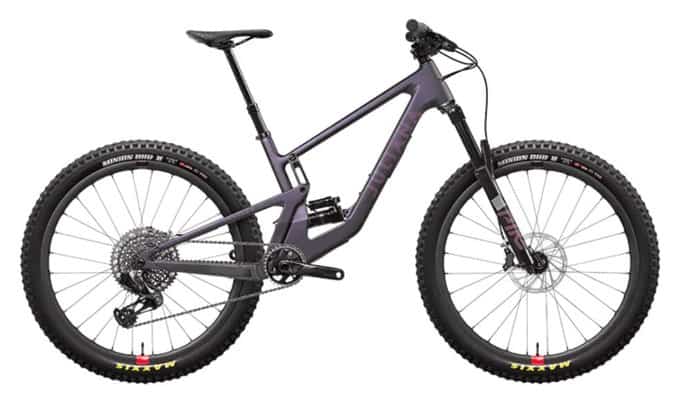
The go-to model for all-round riders, the Furtado proves that what goes up (well) can come down (equally well), too.
The balance of 130mm VPP travel and a 66.5 degree head tube angle delivers a package that’s nimble on tight technical stuff yet perfectly poised on tricky descents too. The upper-link driven VPP design is engineered to be ultra-responsive. A firm initial stroke creates tight pedaling performance straight off the bat, while Juliana’s lighter shock tune remains supple enough to handle small bumps and keep things feeling playful.
Deeper into the travel the progressive shock rate delivers a subtle bottom-out resistance that makes it feel like there’s more travel than there actually is.The Furtado is suitable for almost all types of riders and trails. It has a unique personality that ranges from feisty dance partner on hot laps to trusty companion on more far flung adventures.
Juliana specifies 2.6-inch tires on Reserve 37 rims because they feel it’s the sweet spot between traction and finesse, but there’s still enough clearance for up to 2.8-inch tires for those who want more grip. Some people want a garage full of bikes for every occasion. Others want just one that’s good for any occasion. The Furtado is that bike.
It doesn’t matter how well designed your frame is or how many fancy knobs and levers you can click on your shock—if the internal parts of your suspension aren’t properly tuned for you, you’ll never get the most from your ride.
Juliana staff work closely with Santa Cruz engineers, and the technicians at Fox and RockShox, to develop custom tunes that bring out the best in each of their models. The company then tests those products amongst a diverse group of women to ensure theory meets reality. Juliana is looking for a tune that delivers the best balance of traction and control in the widest variety of situations, and the result is what makes Juliana different.
Furthermore, the Joplin, for example, features all the same great engineering and geometry traits as the Santa Cruz Tallboy, however it offers the typically lighter Juliana rider a plush and smooth feel throughout the travel, thanks to its custom ‘light’ tune. Juliana’s component selection refines your ride even further.
From shock tune to chainring size and saddles to grips, their crew of dedicated female product testers have pored over all the subtle details a modern female mountain biker wants. Juliana doesn’t shout about these details all over the bike itself because we don’t feel they need to. Their founder is one of the fiercest riders of all time—her name on the next section’s model says it all.
Juliana Furtado
This is the flagship bike in the Juliana line, and is burlier than the Joplin. Although the Primeiro carbon version of the Furtado weighs a couple more pounds than its sister the Joplin, its geometry is designed for rockier and more challenging downhills, and it cleverly features internal cable routing for the dropper post.
Rolling on fat 27.5-inch wheels, this trail bike has 125 mm of Virtual Pivot Point travel and a slightly lower center of gravity. The result is a women’s specific mountain bike that feels a bit more stable launching off rock drops, eating up tight corners, and getting air time. But again, the Furtado Primeiro climbs like a rocket, despite its beefier setup, and offers the same smaller handlebars and grips to make braking less taxing on ladies fingers.
The Furtado is also available in the Segundo kit, with an aluminum frame and corresponding lower price point if you like that model better.
Furtado embodies the adventure of mountain biking –hard climbs followed by fast descents, and long days in the woods on two wheels. The advanced VPP (Virtual Pivot Point) design has been refined to create even lower standover heights than the previous model, and the slightly longer top tube allows the use of shorter stems for more responsive handling. The head tube angle, at 67 degrees, is a degree slacker than the old Furtado.
Juliana also made the chainstays 10mm shorter, which results in snappier handling and easier navigation through tight obstacles. It’s a powerful descender and nimble climber that more than lives up to its reputation as Queen of the Mountain. You’ll find that Furtado is now more sensitive to trail inputs, with a softer top end to its suspension.
As you move through the travel, however, the suspension gets more supportive and progressive, so you don’t lose momentum over chunky rocks and big roots.
Juliana Furtado Sizing
The most popular bike in the Juliana line-up gets more capable for the 2021 model, moving further away from the cross-country realm and firmly into the trail category. It still has 27.5-inch wheels, but they’re now paired with a longer travel 140mm fork and a frame that boasts longer and slacker geometry in addition to size-specific chainstays.
The 130mm of rear travel on the third generation Furtado has been updated to the lower link VPP suspension layout, making it difficult to tell the Furtado apart from all the other models in the Juliana line-up that have already been updated: the Roubion, Joplin, and Maverick. The Furtado melds bits of each model into one bike that Juliana says is suitable for those that like to “do-it-all (then do it again).”
Juliana offers the Furtado in three sizes and four builds. Its Santa Cruz counterpart that shares the same frame, the 5010, is offered in the same four builds, but with additional large and XL sizes for each. The Furtado is available in both the high-grade carbon frame known as the “CC” and the regular “C” carbon. Unlike the previous generation, an aluminum version of the bike is not currently available.
The frame fits up to a 27.5-inch x 2.6-inch tire and has well thought out protection including a downtube protector, a fender that keeps mud away from the shock, and a ribbed chainstay protector.
The new Furtado is the first Juliana that uses SRAM’s universal derailleur hanger, which means that all shops, even ones that aren’t Santa Cruz dealers, should be able to help you out if your derailleur collides with a rock or other derailleur hanger-destroying obstacle out on the trail.
Compared to other Santa Cruz models with the lower-link suspension, the Furtado frame has a larger shock tunnel. More room around the rear shock makes it slightly easier to see your sag on your rear shock when you’re setting up the bike and it also means that the Furtado is compatible with coil shocks.
- 🚲Good comfort, effectively reducing the impact of the entire vehicle, improving ride comfort and the life of various parts of the relevant body.
- 🚲Adjustable damping/compression lock/gas pressure can be filled and adjusted / adjustable travel.
- 🚲The air pressure biliary is much lighter than other brands of hydraulic biliary.
- 🚲Super powerful one-key lock, super-powerful damping soft and hard adjustment.
- 🚲100% brand new and high quality.
Prices pulled from the Amazon Product Advertising API on:
Product prices and availability are accurate as of the date/time indicated and are subject to change. Any price and availability information displayed on [relevant Amazon Site(s), as applicable] at the time of purchase will apply to the purchase of this product.
Other details include integrally-molded tubes to make cable routing easier, a threaded bottom bracket, and ISCG-05 tabs for mounting a chain guide or bash guard. The Furtado uses the same frame as the Santa Cruz 5010 but with women’s specific grips and saddle, a shock tune for lighter riders, and different graphics.
While Juliana is a brand for women, they believe the geometry on Santa Cruz Bicycles is the best fit for all riders and don’t see any need to change the geometry for women.
As you may have expected, the new Furtado is longer, lower, and slacker. The medium Furtado V2 had a 67 degree headtube angle and a 425mm reach, while the medium V3 version has a 65.4 degree head tube angle and a 447mm reach. The wheelbase on the size medium is 50mm longer at 1191mmm, while the seat tube angle has gone from 74 to 77 degrees.
You can change the geometry on the Furtado between two settings using the flip chip on the link where the shock mounts. In the Low setting, the head tube angle is 0.3-degrees slacker, the bottom bracket is 4mm lower, and the reach is 3mm shorter.
New for the Furtado and Juliana are proportional chainstay lengths, which means that shorter riders on smaller frames will now have shorter chainstays. The rear swingarms on all models are the same and the different chainstay lengths are achieved by moving the pivots and shock mount in the front triangle to effectively shorten the rear center on different sizes. The XS and small Furtados get 424mm chainstays while the medium gets 427mm chainstays.
The main difference between the kinematics of the new Furtado compared to the previous generation is the shape of the leverage ratio curve. Previously it had a slight hump in the curve where the leverage ratio increased before decreasing. On the new model, that curve is now a diagonal line without any sudden dips or dives. That should mean that the suspension ramps up smoothly through its travel, with a consistent feel from beginning to end.
With a wider shock tunnel, the new Furtado is compatible with a coil shock. Since it has a rising rate linkage, Juliana says it will work better with a coil than most bikes in this travel range, but you should keep in mind that on a shorter-travel platform, you’ll need a pretty firm spring to keep from bottoming out too much with a coil, as you don’t have the advantage of an air spring’s ramp-up.
Juliana Joplin
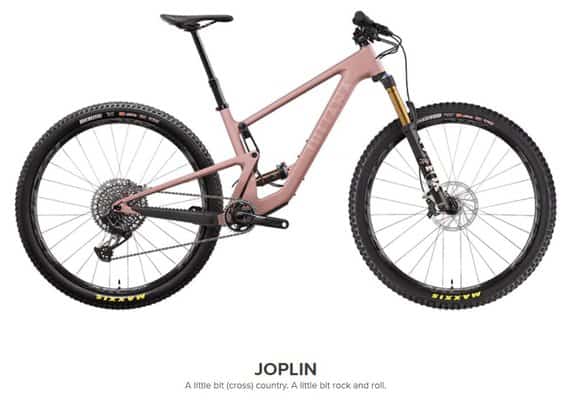
Part endurance racer, part rowdy trail bike—the Joplin is ridiculously fun. The original model redefined what people thought a 29er could be. This latest version breaks the mold all over again. Conventional wisdom always held that a big-wheel bike like this was good for one thing—covering lots of ground quickly. We’ve never had much use for conventional wisdom.
Yes, the Joplin is a fine cross-country/endurance machine. With its light-yet stiff carbon frame, efficient VPP rear suspension, and 29-inch wheel option, this bike can be an absolute race weapon—but the Joplin is more than that. The Joplin has always been, to reduce this thing to a single word, fun. As in the uncontrollable-giggling-spontaneous-high fiving kind of fun.
Juliana cranked the knob on that particular trait to 11 this year with a ground-up redesign that increases the bike’s composure on descents, adds a bit more small-bump suppleness to the mix and improves its handling in tight turns. The new Joplin also gives you the option of running either 29er or 27.5+ wheels. If you’re looking for quick acceleration and a nimble feel, go 29er.
If you’re wanting extra traction and a more forgiving ride over roots and baby head rocks, go 27.5+. It’s your choice. Is the Joplin a cross-country racer? Sure. A trail bike? Absolutely. Is it fun? Oh, heck yes. This CC-level carbon frame is every bit as stiff and strong as our C-level frames, but weighs about 280 grams less, due to the use of some lighter, stronger, and more expensive carbon fiber.
Using this material in key places allowed us to use less material overall, which is what shaves off more than half a pound from the frame. Named for the “Queen of Rock and Roll,” this is a spectacular ride for many. Weighing in at just over 25 pounds locked and loaded, the top of the line Joplin Primeiro sports a carbon frame and 100 mm of travel. This powder blue 29er looks like a princess, but don’t let its looks fool you.
The Joplin is lethal on a cross country ride, and can more than hold its own against some of the more popular male-oriented mountain bikes you will see out on the trail. This women’s specific 29er climbs like a mountain goat crossed with a cheetah.
The best thing of all is that someone finally built a women-specific mountain bike for those ladies with higher standards. Geared up with Shimano Deore XT drivetrain and XT disc brakes, and topped off with Fox 32 Float 120 mm front and Fox Float rear shocks, this bike is made for a serious female rider.
The smaller frame sizes utilize Santa Cruz’s exceptional frame geometry to create the utmost comfort for smaller framed women, typically those standing 5’4-inches and weighing in at 115 pounds. The bars and super narrow grips fit many small hands like a glove, adding control and safety to a downhill shred.
Honestly, many riders have never felt so comfortable on any bike they have ever ridden.
Juliana Maverick
With the longest reach and wheelbase on test, and a relatively low bottom bracket, the Maverick has the most aggressive frame shape, for confident descending. The chainstays are kept short (433mm) to increase agility. Santa Cruz’s twin-link VPP suspension system stands out, with the shock half-hidden within the seat tube and behind the swingarm.
A little guard protects the Fox DPS damper from any grit spraying up from the rear wheel, which is a nice touch, although it makes it hard to set your sag and complicates maintenance.
The shock is mounted to the lower link via an integrated flip-chip, which can be switched between ‘High’ and ‘Low’ geometry settings.
While the bike comes with 29-inch wheels, you can also run 650b hoops with up to 2.8-inch tires (in which case, Juliana recommends using the High setting).
While the frame is high quality, the kit isn’t quite up to scratch for the price. SRAM’s NX Eagle drivetrain is second-from-bottom in its 12-speed range. Experience suggests it’s wise to keep an eye on the bolt torque and mech alignment.
The Race Face dropper works alright, but isn’t the swiftest-returning post, and some riders found the saddle a bit chunky too.
Juliana recommends running the Maverick in the High setting if you struggle with pedal strikes. Many may prefer shorter crank arms – 170mm instead of 175mm – to avoid this, and to keep it in Low for a better feel on descents. The shorter crank option is only available on the small size.
RockShox’ Yari fork shares the same strong chassis and DebonAir spring as the more sophisticated Lyrik, but uses the older Mission Control damper so lacks suppleness.
- RockShox
- Yari RC Suspension Fork
- Suspension Fork
Prices pulled from the Amazon Product Advertising API on:
Product prices and availability are accurate as of the date/time indicated and are subject to change. Any price and availability information displayed on [relevant Amazon Site(s), as applicable] at the time of purchase will apply to the purchase of this product.
The Fox shock has a climb lever, but many choose to never reach for it because the bike’s kinematics allow for efficient pedaling. Unfortunately, the SRAM Guide R rear brake may need a bleed after only one ride.
Sitting on the Maverick before you drop in for a descent fills you with confidence. The long-ish reach, more enduro-flavored head angle, lower bottom bracket, big wheels and sturdy fork make you feel like you can tackle anything.
Unfortunately, the bike doesn’t make the downhills as effortless as first appearances would suggest. While the long wheelbase provides a stable platform on fast descents, the harsh-feeling suspension makes rough tracks even tougher than normal on the arms.
Santa Cruz Maverick Juliana
Overall, the Maverick feels energetic, even more so than it’s 150 mm fork and 140 mm rear end might suggest. The bike is planted through rough terrain and loose corners, but eggs you on to go off every feature and take the more challenging line. Not many bikes manage to do that as well as this bike does while managing to pedal with any amount of efficiency. It’s a worthwhile combination and one that plenty of women (or anyone) will love riding.
This 29er mid-travel mountain bike is geared first and foremost to be a trail bike, but on tighter trails that require quick maneuvering, this can work well as an enduro bike. At least the Juliana EWS team seems to think so – they’re pairing 160 mm forks to this bike and letting it rip. Not everyone needs that though, and for a majority of riders, the stock suspension setup will handle just about anything while retaining a sense of nimbleness.
The Maverick’s carbon frame with its lower-link mounted shock VPP design looks similar to the Roubion, but has bigger wheels and 10mm less travel front and rear. It’s available in both the high-grade carbon frame known as the “CC” and the regular “C” carbon.
Coil shocks are not compatible with the frame, and neither are the Fox Float X2 or Cane Creek DB Air. Juliana recommends the RockShox Super Deluxe, Deluxe, Fox DPX2, or Fox Float DPS.
- Revolutionary innovation
- Performance that is simply second to none
- Achieve the ultimate ride
Prices pulled from the Amazon Product Advertising API on:
Product prices and availability are accurate as of the date/time indicated and are subject to change. Any price and availability information displayed on [relevant Amazon Site(s), as applicable] at the time of purchase will apply to the purchase of this product.
Other frame details include a shuttle guard, a downtube protector, a fender that keeps mud away from the shock, a ribbed chainstay protector, room to mount a water bottle on the top of the downtube on all sizes, a threaded bottom bracket, and ISCG-05 tabs for mounting a chain guard. You can run up to a 36t chainring on the Maverick. Juliana’s geometry chart for the Maverick is based off of a 150mm fork with a 44mm offset.
They don’t recommend riding the bike with less travel than 150mm as the bottom bracket will get a bit low, but they have no problem with riders bumping up the travel to 160mm if that’s your preference. In fact, the Juliana-SRAM Pro Team riders have all been riding their Mavericks with a 160mm fork.
The Maverick is compatible with 27.5 x 2.-inch tires in addition to the 29 x 2.-inch spec that comes on the bike. If you do decide to ride smaller wheels on this bike, Juliana recommends that you ride in the High BB setting with a 160mm fork to keep the BB height in the right range.
This is the first Juliana offered in a Large, but you’ll notice there’s no XS frame size for the Maverick. Juliana says that the longer travel in a 29-inch platform makes it hard to make that size.
The Small size comes with a 125mm dropper, the Medium comes with a 150mm dropper and the Large comes with a 170mm dropper. That being said, many riders find that they are able to throw a leg over the Medium that Juliana-SRAM Pro Team’s Brittany Phelan was riding and find that they can comfortably fit a 170mm RockShox Reverb Stealth with a 27-inch inseam.
Juliana Roubion
Roubion is the race bike of choice for the ladies of the Juliana SRAM Pro Team, and has evolved to meet the demands of their grueling Enduro World Series campaign. The aggressive, 66-degree head angle now makes the Roubion even more stable when descending at speed. The top tube length has increased to accommodate the use of shorter stems, and the chainstays have been shortened to keep the rear end tight and quick through alpine hairpins.
The seat tube angles are also a degree steeper, which puts the rider right above the bottom bracket, where you’ll be at an angle to generate positive traction on even the most technical climbs. The new model retains 150mm of VPP travel, but features an entirely new set of links. The lower link now hides completely out of the way, and the upper mounts directly to the top tube to enhance stiffness and bearing life.
The highly tunable Cane Creek Double Barrel Air, with its four-way independent adjustability may take a little bit of fettling to get set-up to its optimum. The results of the Cane Creek technology are an extremely planted ride and a feeling of complete synergy with the frame, small bump sensitivity was exceptional and soaking up big hits was plush without the downside of any wallowing.
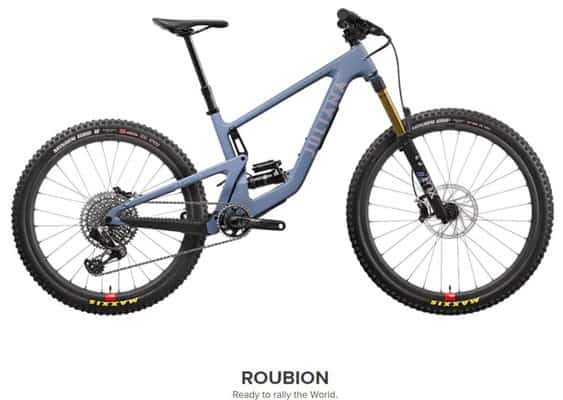
When this is added into the mix with the VPP suspension, you get a bike that pedals extremely well, pedal bob was pretty much eliminated, and descends like a mini-downhill bike. The Roubion is a whoop-and-holler kind of bike. It will put a smile on your face whatever the terrain and will make you feel like a riding goddess. It has a stiff, stable and smooth ride yet nimble and fun at the same time.
Whether you’re pointing it up or down, riding it for pleasure or thrashing it at race speed, it’s hard to find a fault with this bike. It’s a serious shredder for women who want a bike that can cope with it all.
As a result of the new Double Barrel Air, the shock rate is now softer at the top end, which makes for a smoother ride over small bumps. Towards the middle of its six inches of travel, it gets a bit more progressive, so you’ll feel confident and composed when you’re riding through bigger roots and rocks at speed. As Juliana riders continue to push their boundaries, the Roubion stays right there with them.
Juliana has realized that women want the option of a high end kit and have provided the Roubion with a top-of-the-range spec list and upgrade options. With the choice between X01 and XX1, Fox Float CTD and Cane Creek Double Barrel Air, you really can build the Roubion of your dream – wallet-allowing that is.
For many Juliana fans, these are some of the reasons the Roubion has fast become one of its most popular models inside of a line with innovative bikes.



